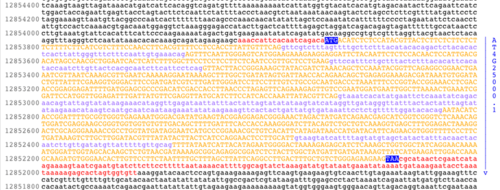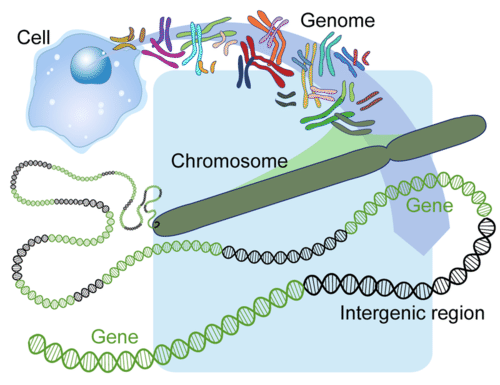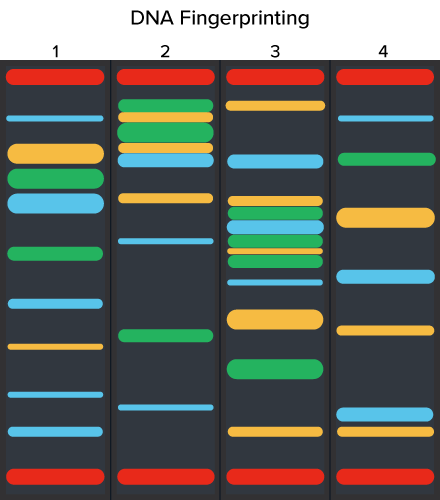3.15 人类基因组 -- -- 先进
章节大纲
-
What are all these ACGTs ?
::这些ACGT是什么?These represent the sequence of nucleotides in a gene . Over three billion of them from a human form the human genome - the human genetic material - all the information needed to encode a human being. It would take about 9.5 years to read out loud - without stopping - the more than three billion pairs of bases in one person's genome .
::它们代表了基因中的核分裂剂序列。其中30亿来自人类基因组,人类基因材料,所有对人进行编码所需的信息。需要大约9.5年的时间才能大声地阅读一个人的基因组中30亿对以上的基底,而不会停止。The Human Genome
::人类基因组What makes each one of us unique? You could argue that the environment plays a role, and it does to some extent. But most would agree that your parents have something to do with your uniqueness. In fact, it is our genes that make each one of us unique – or at least genetically unique. A gene is a segment of that has the instructions to encode a or molecule and give you a trait.
::是什么使我们每个人都具有独特性?你可以争辩说,环境扮演着一种角色,它在某种程度上也起到一定的作用。 但大多数人会同意,你的父母与你的独特性有关。 事实上,正是我们的基因使我们每个人都具有独特性 — — 或至少是基因上的独特性。 基因是具有编码一个或一个分子并给你一个特性的指示的一部分。We all have the genes that make us human: the genes for skin and , and ears, fingers and toes, and so on. However, we all have different skin colors, different bone sizes, different eye colors and different ear shapes. In fact, even though we have the same genes, the products of these genes work a little differently in most of us. And that is what makes us unique.
::我们都有使我们成为人类的基因:皮肤和耳朵的基因、耳朵、手指和脚趾等等。然而,我们都有不同的肤色、不同的骨骼大小、不同的眼睛颜色和不同的耳朵形状。事实上,尽管我们有相同的基因,但这些基因的产物对我们大多数人的作用却有所不同。这就是我们的独特性。The human genome is the genome - all the DNA - of Homo sapiens . Humans have about 3.2 billion bases of information, divided into roughly 20,000 to 23,000 genes, which are spread among non-coding sequences of DNA and distributed among 24 distinct (22 autosomes plus the X and Y sex chromosomes) ( Figure ). These 24 chromosomes are arranged into 23 pairs: 22 pairs of autosomes, numbered 1-22, with chromosome 1 being the largest and chromosome 22 the smallest, and one pair of sex chromosomes . Females have a pair of X chromosomes, while males have an X and a Y chromosome .
::人类基因组是智人基因组,所有DNA都是。人类有32亿个信息基础,分为大约20 000至23 000个基因,分布在DNA的非编码序列中,分布在24个不同的基因组(22个有机体加上X和Y性染色体)(图)。这24个染色体分为23对:22对有机体,编号为1-22,染色体1是最大的,染色体22是最小的,染色体一对,性染色体一对。女性有1对X染色体,男性有1对X和1对Y染色体。The genome is all of the hereditary information encoded in the DNA, including the genes and non-coding sequences. The (see the DNA Technology: The Human Genome Project (Advanced) concept) has produced a reference sequence of the human genome. The human genome consists of protein-coding exons , associated introns and regulatory sequences, genes that encode other RNA molecules, and “junk” DNA, regions in which no function has yet been identified.
::基因组是DNA编码的所有遗传信息,包括基因和非编码序列,(见DNA技术:人类基因组项目(高级)概念)产生了人类基因组的参考序列,人类基因组包括蛋白质编码出处、相关的电文和监管序列、将其他RNA分子编码的基因和“垃圾”DNA,这些区域尚未确定功能。Human Genome, Chromosomes, and Genes. Each chromosome of the human genome contains many genes as well as noncoding intergenic (between genes) regions. Each pair of chromosomes is shown here in a different color. Notice that there are 23 pairs of chromosomes. Satellite DNA and Transposons
::卫星DNA和转基因卫星The majority of the human genome is non-coding sequence. These sequences include regulatory sequences and DNA with unknown functions. These sequences include tandem repeat elements known as satellite DNA and transposons. Satellite DNA consists of very large arrays of tandemly repeating, non-coding DNA. The repeating units can be just a single base (a mono nucleotide repeat), two bases (a dinucleotide repeat), three bases (a trinucleotide repeat) or a much larger repeating unit. Some repeating units are several thousand base pairs long, and the total size of a satellite DNA segment can be several megabases without interruption.
::大部分人类基因组是非编码序列。这些序列包括监管序列和具有未知功能的DNA。这些序列包括连带重复元素,称为卫星DNA和转基因生物。卫星DNA由大量串连重复的、非编码的DNA组成。重复单位可以是单一的基数(单核核酸重复)、两个基数(二核酸重复)、三个基数(三核酸重复)或一个大得多的重复单位。有些重复单位是几千对基数长的基数,而卫星DNA部分的总大小可以是几个无间断的巨型基数。Other tandem repeat elements include minisatellite and microsatellite DNA. Both of these are also known as which is also known as VNTRs , for variable number of tandem repeats. Their analysis is useful in genetics and biology research, forensic science , and DNA fingerprinting. Minisatellite DNA is a section of DNA that consists of a short segment of repeating units 10-60 bp long. These occur at more than 1,000 locations in the human genome. Microsatellite DNA has smaller repeating units. Microsatellites are also known as simple sequence repeats (SSRs) or short tandem repeat (STR) polymorphisms. STR analysis forms the basis of identification in forensic DNA analysis. 13 STRs are routinely analyzed from throughout the human genome as part of CODIS , the Combined DNA Index System database maintained by the FBI.
::微型卫星DNA是DNA的一个部分,由10-60bp长的重复单元组成,在人类基因组的1,000多个地点出现; 微型卫星DNA的重复单元较小; 微型卫星的重复单元也称为简单序列重复(SSRs)或短串重复(STRs)多式分析。 可疑交易分析是法医DNA分析中鉴定的依据。 13个可疑交易报告作为CODIS的一部分,定期从整个人类基因组中分析,这是联邦调查局维持的DNA综合索引系统数据库。This illustration is an example of DNA fingerprinting. The colored bands represent segments of DNA, separated based on size. 3 individuals are tested for 6 STRs. Lane 1 represents a molecular weight marker, a standard set of DNA fragments of known size. Notice that the pattern of bands is unique for each individual. DNA sequences that repeat a number of times are known as repetitive sequences or repetitive elements. For example, the sequence CACACACACACACA would be a dinucleotide (2 base) repeat, or the sequence GATCGATCGATCGATCGATC would be a tetranucleotide (4 base) repeat. The genomic loci and length of certain types of repetitive sequences are highly variable from person to person, which is the basis of DNA fingerprinting and DNA paternity testing technologies. Longer repetitive elements are also common in the human genome. Examples of repeat polymorphisms are described in the Table .
::例如,CACACACACACACACAA序列为二核酸重复(2个基底),或GATCGATCGATCGATCGATCGATCGATGAGATCGATCTATCTATCT的序列为四核酸重复(4个基底),某些类型的重复序列的基因组分布和长度因人而异,这是DNA指纹鉴定和DNA亲子鉴定检验技术的基础。Repeat Polymorphisms (bp = base pair) POLYMORPHISM REPEATS Mononucleotide repeats of one bp Dinucleotide repeats of two bp sequences Trinucleotide repeats of three bp sequences Tetranucleotide repeats of four bp sequences Microsatellite ; Short Tandem Repeats (STRs) short sequences of 100-200 bp, usually due to repeats of 1-6 bp sequences Minisatellite sequences of 100-200 bp, usually due to short sequences of 10-60 bp repeats VNTR : Variable Number of Tandem Repeat short nucleotide sequence ranging from 14 to 100 nucleotides long, organized into clusters of tandem repeats, usually repeated in the range of between 4 and 40 times per loci Transposons include retrotransposons and transposable elements. A transposable element is a DNA sequence that can change its relative position (self-transpose) within the genome of a single . Transposable elements either "cut and paste" or "copy and paste" themselves to move around the genome. This does result in a change in the DNA sequence and by definition, is a . Some of the transpositions can result in severe phenotype changes. Barbara McClintock's discovery of these "jumping genes" earned her the 1983 in Physiology or Medicine. Retrotransposons are a subclass of transposons. They are genetic elements that can amplify themselves in a genome.
::可移植元素是DNA序列,可以改变其在单一基因组中的相对位置(自我传输)。可移植元素要么是“切除和粘贴”,要么是“复制和粘贴”本身在基因组周围移动。这确实导致DNA序列和定义的改变。一些转移位置可能导致严重的苯型变化。芭芭拉·麦克林托克发现这些“跳跃基因”在1983年在生理学或医学上赢得了她。反转基因是基因的子分类。它们是遗传元素,可以在基因组中自我放大。Variation
::变式As stated above, even though we essentially all have the same genes, the gene products work a little differently in all of us, making us unique. That is, the variation within the human genome results in the uniqueness of our . In fact, genetically speaking, we are all about 99.9% identical. However, it is this 0.1% variation that results in our physical noticeable differences, as well as traumatic events such as illnesses or congenital deformities. These differences can also be used for society's benefits, such as through forensic DNA analysis. Most studies of this focus on small differences, know as SNPs , or single nucleotide polymorphisms , which are substitutions in individual bases along a chromosome. For example, the single base change from the sequence GGATAACGTCA to GGAAAACGTCA would be a SNP. Although not occurring uniformly, in the human genome, it has been estimated that SNPs occur every 1 in 100 to 1 in 1000 bases.
::如上所述,尽管我们基本上都拥有相同的基因,基因产品在我们所有人中的作用都略有不同,使我们具有独特性。也就是说,人类基因组的变异导致我们的独特性。事实上,从基因学上讲,我们都是99.9%的相同者。然而,正是这种0.1%的变异导致了我们身体上的明显差异,以及疾病或先天畸形等创伤性事件。这些变异也可以用于社会利益,例如通过法医DNA分析等。大多数这种变异都集中在小差异上,如SNPs或单核核酸多元形态,这些差异是个人基底与染色体的替代。例如,从GGATACGATACGCAGTCATCA到GGAAACGTCA将是SNP的单一基底变化。尽管在人类基因组中情况并不一致,但估计SNPs每100到1000个基中每100到1个基中发生一次。Mitochondrial DNA
::米托贡德里DNAAdditionally, small mitochondrial DNA is found in human and contributes to the genome. Human mitochondrial DNA is a circular molecule, on average 16,569 nucleotides long and contains 37 genes. 100s to 1000s of these DNAs can be present in a single cell. Due to the cytoplasmic location of the mitochondria, mitochondrial DNA is strictly inherited form the mother. The structure of this DNA is similar to that of a , and is one piece of evidence supporting the Theory of Endosymbiosis .
::此外,在人类体内还发现了小型的线粒体DNA,这种DNA有助于基因组。人类的线粒体DNA是一种圆形分子,平均长16 569个核糖核酸,含有37个基因。这些DNA中100至1000个可以存在于单细胞中。由于米托昆氏体的细胞结构,线粒体DNA是严格遗传的母体。这种DNA的结构类似于一个DNA的结构,也是支持恩多辛生物论的证据之一。Summary
::摘要-
The genome refers to all the DNA of a particular species.
::基因组是指特定物种的所有DNA。 -
The human genome consists of 24 distinct chromosomes: 22 autosomal chromosomes, plus the sex-determining X and Y chromosomes.
::人类基因组由24个不同的染色体组成:22个自相相色谱体,加上性别确定X和Y染色体。 -
In addition to coding sequences, the human genome includes non-coding sequences of regulatory sequences, transposons, and satellite DNA.
::除了编码序列外,人类基因组还包括监管序列、转口和卫星DNA的非编码序列。
Review
::回顾-
Define and describe the human genome.
::界定和描述人类基因组。 -
What is the Human Genome Project?
::什么是人类基因组项目? -
What is satellite DNA? Describe the various types.
::卫星DNA是什么? -
What is a transposable element? What do they result in?
::什么是可移植元素?它们的结果是什么?
-
The genome refers to all the DNA of a particular species.


